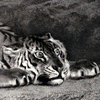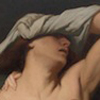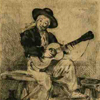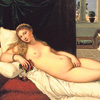Courbet is hailed as one of the masters of realism, so I find it interesting that he is found in accordance with the emulation of Manet, a founding father of Impressionism. Courbet is also hailed by theologist Paul Tillich as one of the artists who waved the banner of the Protestant Principle, that is, that they created art that was free of the farsighted judgment of religious pride, ecclesiastical superiority and secular seclusion and the resulting “destructive” consequences. He discusses the transition from the religious themes of the old masters, to the “protestant” ideals of these new secular works, stating that, “It is this Protestant principle of criticism which enlightened artists employ when they use the prophetic style to open the eyes of the viewer to customarily lost truths and as a means of personal and social criticism” (Kegley 178). Tillich thinks that Courbet's Wave (Fig. 1) was one of the first works to really highlight these new ideals as it emphasizes the role of nature rather than the role of God. Realism, in accordance with Protestant Principle, shied away from classical and romantic themes, and was instead based on direct observation of the modern world. In 1861 Courbet was quoted as saying that "painting is an essentially concrete art and can only consist in the representation of real and existing things," and thusly realists often strove to make a statement about the stark middle class conditions in Europe. While it is true that a religious shift may have been taking place at this time encouraging Courbet to eschew the old subjects of biblical scenes and mythological traditions, I think that perhaps the artistic shift in styles is also at play. Whatever the reason it is clear that Courbet has looked to The Battle of the "Kearsarge" and the "Alabama" for inspiration towards his famed Wave. The emotion laden canvas and palette capture the immediacy of waves crashing in a manner that the “concrete” realist painting that Courbet speaks of cannot, and it is clear that his wave was made after Manet’s. It is really not so strange that a realist like Courbet would adopt these tools for capturing instantaneity although impressionism and realism are often opposing styles. However, as stated in The Series Paintings of Claude Monet and the Landscape of General Relativity, “when one is dealing with concordant appearances, one cannot be far from reality, or at least what we know of it (Chandrasekhar 10).” In his effort to capture his direct observations, Courbet embodied Manet’s mantra of painting as nature happens and not as the artist expects it to. During his life Courbet was often criticized greatly for his heavy use of the palette knife technique to layer paint on a canvas; something also associated with Manet and the impressionist movement. His chunky application of paint became so famous that it was even caricatured, and it is evident in this detail of part of his Wave series (Fig. 6).
In conclusion, impressionism may be based on the ideal of originality and immediacy, but that does not mean that it is free from the influence of the masters, or that it is immune to imitation. Édouard Manet trail blazed a new style of painting that dealt with in the moment interpretations of a landscape and encouraged the release of all previous notions of the subject. In considering his The Battle of the "Kearsarge" and the "Alabama" in relation to Claude Monet’s Green Wave and Gustave Courbet’s Wave it is obvious that while these other artists applauded the idea of this impressionist style, they could not entirely adhere to it’s ideals as they looked to Manet for inspiration for their own work. I do not in fact find it terribly shocking that Courbet, a realist, has in this instance been caught emulating the Impressionist Manet as the Impressionist movement strove to capture moments just as they occurred and Courbet’s brand of realism focused on direct observation of his life. Manet and other impressionist did not completely ignore reality; they simply focused on one moment of reality and put their effort into rendering that specific landscape. The paintings discussed in this paper are all examples of how emulation is defined in an art history vein, that is, “imitation with the intention to surpass.” Each of these artists took the ideals and inspirations of Manet and made them their own, building upon the style until they too were considered masters.
Bibliography
Chandrasekhar, Subrahmanyan, The Series Paintings of Claude Monet and the Landscape of General Relativity. Pune: Inter-University Centre for Astronomy & Astrophysics, 1992.
Cooper, Douglas. "The Monets in the Metropolitan Museum." Metropolitan Museum Journal 3 (1970), pp. 291–92, 294, 302–5, fig. 14.
"Heilbrunn Timeline of Art History." Nineteenth-Century French Realism. Metropolitan Museum of Art, 2012. Web. 29 Apr. 2012. <http://www.metmuseum.org/toah/hd/rlsm/hd_rlsm.htm>.
Keglev, Charles. Paul Tillich on the Philosophy of Art The Journal of Aesthetics and Art Criticism, Vol. 19, No. 2 (Winter, 1960), pp. 175-184.
Mallarmé, S. "The Impressionists and Edouard Manet." Art Monthly Review (1876). Accessed 12 April 2012, http://www.rae.com.pt/mallarme%20on%20manet%20completo.pdf.

















